Top BIM Tools for Solar Energy Performance Analysis

Building Information Modeling (BIM) tools are essential for designing efficient solar energy systems. They allow engineers to simulate solar performance, optimize panel placement, and ensure compliance with U.S. energy standards like LEED and ASHRAE. Here’s a quick summary of the top tools:
- EasySolar: AI-powered solar design with 6D modeling, financial analysis, and CRM tools. Great for small to medium solar businesses.
- Autodesk Insight: Integrated with Revit for energy modeling and carbon impact analysis. Ideal for architects and engineers.
- IESVE: Comprehensive building performance analysis with lifecycle tracking, solar feasibility studies, and U.S. energy code compliance.
- PVsyst: Specialized in detailed PV system simulations, including shading and energy output predictions. Best for solar engineers.
- Sefaira: Focused on early-stage design optimization, offering energy modeling and daylight analysis integrated with Revit and SketchUp.
Each tool has strengths tailored to specific project phases and goals. Below is a quick comparison table for easy reference:
| Tool | Key Feature | Best For | U.S. Compliance | Pricing |
|---|---|---|---|---|
| EasySolar | AI-driven solar design & CRM tools | Small to medium businesses | Yes | $25–35/user/month |
| Autodesk Insight | Revit integration, carbon analysis | Architects, engineers | Yes (LEED, ASHRAE) | Subscription-based |
| IESVE | Full lifecycle solar analysis | Large-scale projects | Yes (Title 24, IECC) | Enterprise license |
| PVsyst | Detailed PV simulations | Solar engineers | Yes (NEC, IEEE) | One-time purchase |
| Sefaira | Early-stage energy modeling | Architects | Yes (LEED, ASHRAE) | Subscription-based |
Choosing the right tool depends on your project needs – whether it’s early-stage design, detailed PV system analysis, or lifecycle tracking.
1. EasySolar
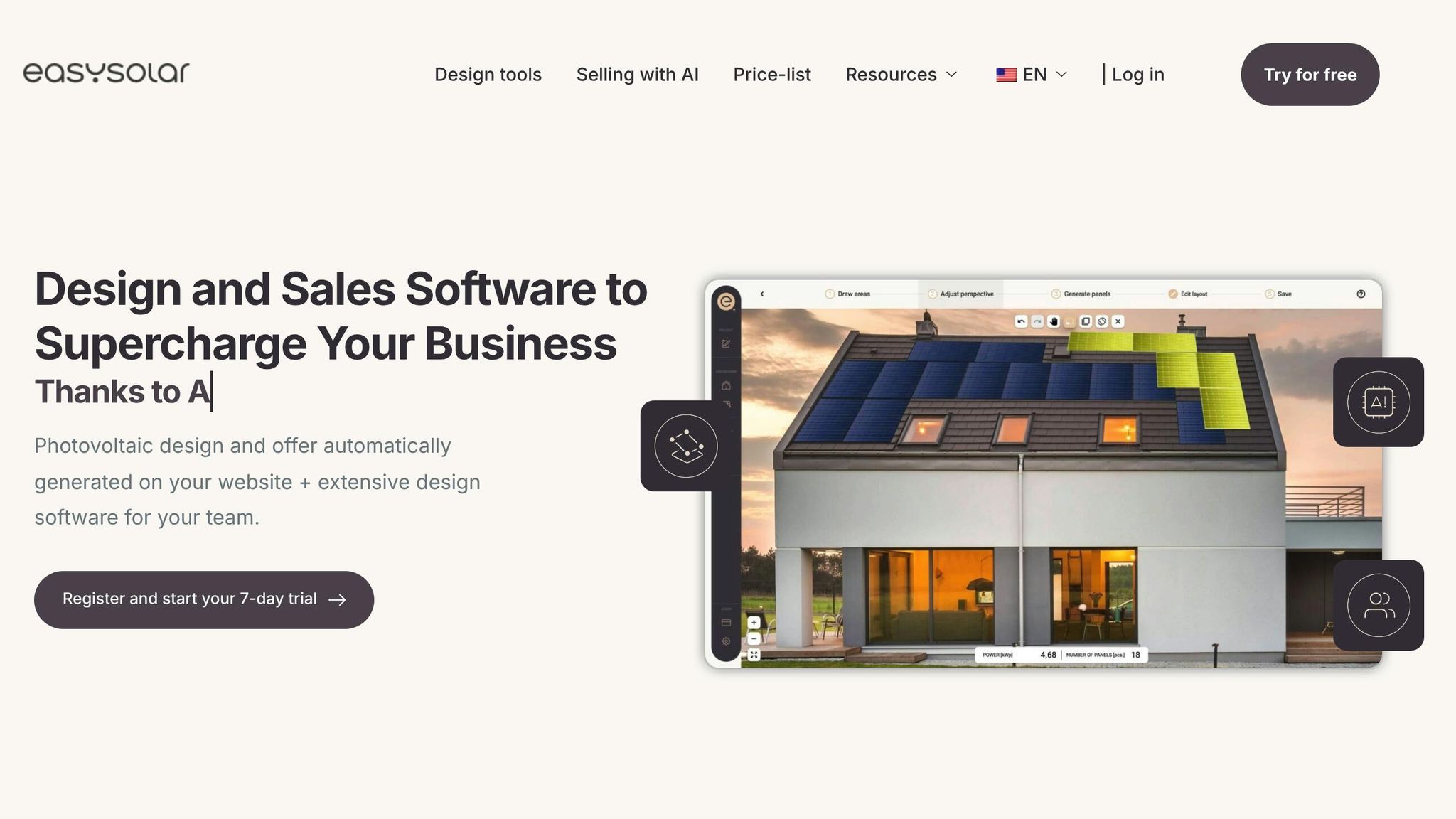
EasySolar combines AI and Building Information Modeling (BIM) to refine photovoltaic system design and performance analysis. By blending advanced modeling tools with AI-driven insights, the platform covers everything from initial design to ongoing performance monitoring. Here’s how EasySolar’s BIM integration and performance analysis features enhance solar installation workflows.
BIM Integration Capabilities
EasySolar uses a 6D modeling approach that goes beyond traditional 3D modeling by incorporating energy efficiency and sustainability metrics. It supports Industry Foundation Class (IFC) data sharing, ensuring smooth compatibility with other BIM tools commonly used in architecture, engineering, and construction.
This integration allows for seamless collaboration across disciplines like architecture, structural engineering, and electrical installations. Using AI, EasySolar optimizes critical factors such as panel positioning, tilt angles, and overall system layout, all tailored to the building’s BIM data and local environmental conditions.
Solar Energy Performance Analysis Features
EasySolar enhances design precision with real-time performance insights. Its energy simulation tools enable users to evaluate lifecycle performance while factoring in obstacles like structural features, nearby buildings, and seasonal shading patterns. The platform’s AI automatically generates solar panel layouts, ensuring optimal energy production.
Additional features include automatic electrical diagram generation and financial analysis tools to evaluate long-term project profitability. Users can conduct in-depth energy performance studies and natural lighting analyses directly within the software. For better visualization, EasySolar creates realistic renderings over drone-captured images, offering clear insights into system performance.
U.S. Compliance and Localization
EasySolar is tailored to meet U.S. standards, offering multi-currency support and localized analytics. It aligns with American measurement systems and integrates with local building codes and regulations. Solar installers can generate branded PDF proposals that comply with regional requirements.
The platform also includes CRM tools designed for U.S. users, such as sales tracking and performance monitoring. These tools help teams navigate local permitting processes and utility interconnection timelines efficiently.
Strengths and Limitations
EasySolar’s standout feature is its AI-driven automation, which significantly reduces design time while maintaining high accuracy in performance predictions. Its ability to work with drone imagery and various map types adds flexibility, making it a favorite among many solar installers. The platform’s unified approach – combining design, sales, and project management – streamlines workflows for solar businesses.
However, there are some limitations. The pricing model may be restrictive for smaller teams, as it requires a minimum of two users for the Basic plan ($25/user/month) and ten users for the Plus plan ($35/user/month). While its BIM integration is robust, teams handling large-scale commercial or utility projects might need additional specialized tools for advanced structural analysis.
2. Autodesk Insight
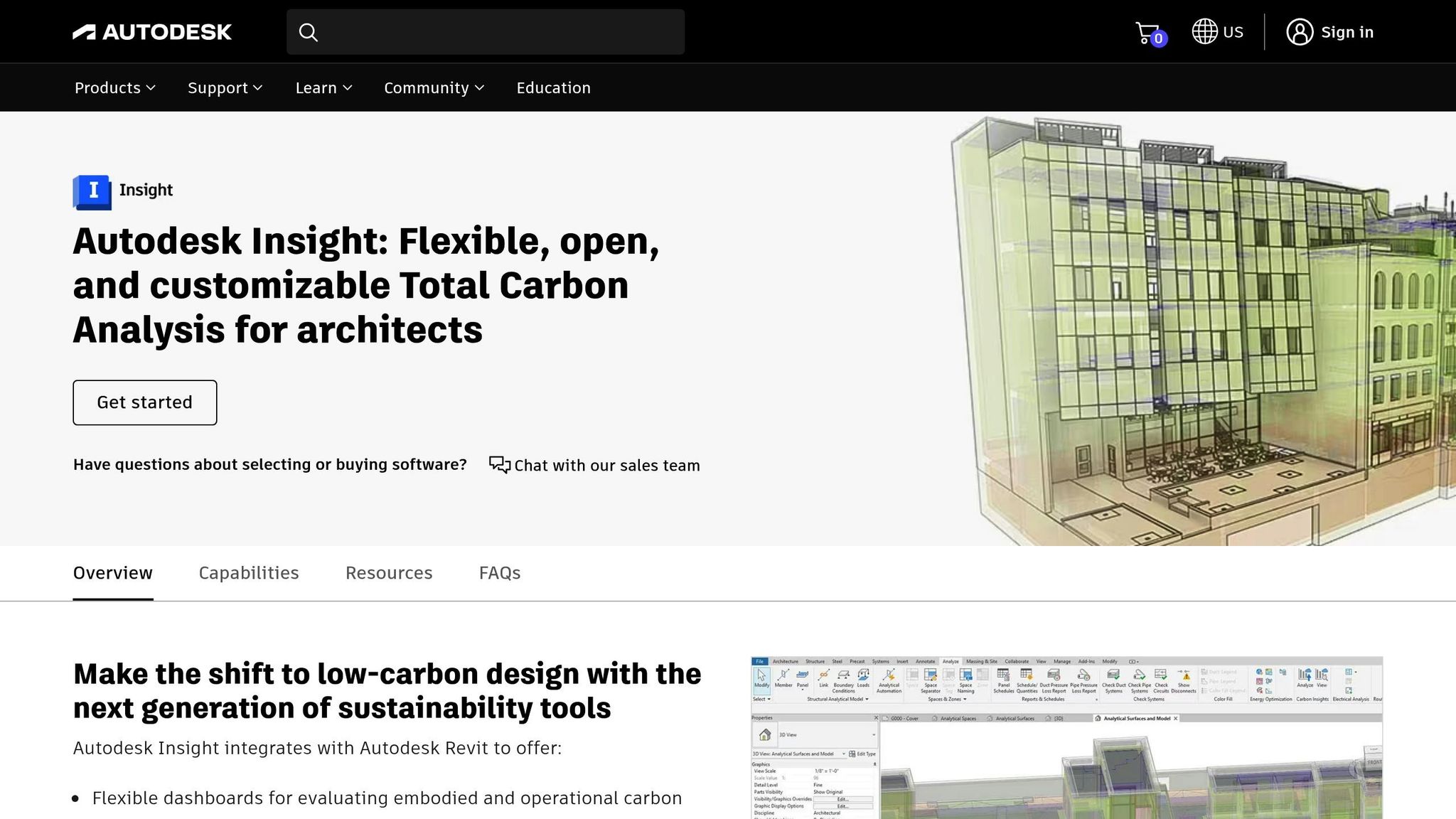
Autodesk Insight offers powerful tools for analyzing carbon impacts and solar performance, seamlessly integrated into Revit. It focuses on both embodied and operational carbon, making it an essential resource for architects and engineers aiming to design sustainable buildings with solar installations. Let’s dive into its standout technical features.
BIM Integration Capabilities
Autodesk Insight works as an extension within Autodesk Revit, tapping into the Revit Energy Analytical Model to evaluate building performance. This integration simplifies workflows for AIA2030 reporting, making it easier for professionals to document compliance for sustainable projects. By connecting directly with Revit, Insight streamlines energy modeling and reporting, saving both time and effort.
Solar Energy Performance Analysis Features
Insight’s solar analysis tools are available through dedicated Solar Analysis extensions for Revit, which users can download from the Autodesk Account under the Products and Services section. By utilizing EnergyPlus – an open-source simulation engine trusted worldwide – Insight delivers precise calculations of operational carbon. This ensures accurate energy performance modeling, including the contributions of solar systems to a building’s efficiency.
The platform also visualizes Revit data to show how renewable energy offsets carbon impacts. Customizable dashboards allow users to monitor solar performance metrics, tailoring their analysis to meet specific project needs and local energy standards. This flexibility puts users in charge of their carbon analysis journey, enabling detailed insights into solar energy performance.
U.S. Compliance and Localization
Insight is particularly well-suited for U.S.-based projects, thanks to its support for AIA2030 compliance and integration with the EC3 database for embodied carbon data. Its alignment with the AIA2030 Commitment makes it a valuable tool for architectural firms aiming to meet carbon reduction goals.
For embodied carbon analysis, Insight connects with Building Transparency’s EC3 database, which provides material-specific carbon data relevant to U.S. construction practices. Users can replace default values or add custom definitions for more accurate assessments. Additionally, Insight’s reporting capabilities align with various U.S. green building certification programs and energy codes, ensuring projects meet evolving sustainability standards with ease.
Strengths and Limitations
One of Autodesk Insight’s biggest strengths is its seamless integration with Revit, offering robust carbon analysis features. It provides early-stage insights into sustainability by quantifying carbon footprints during the design phase. For example, The Mills Group uses Insight to analyze 3D models and track real-time environmental performance, while the global firm Page relies on the tool to model building performance across multiple projects as part of its AIA2030 Commitment.
"Next Gen Insight represents a paradigm shift from a traditional model-centric approach, where models dictate and limit ‘insights’, to a data and dashboard approach which puts the user in control of their carbon insight journey. I believe it is the first step among many that will link building simulation professionals to sustainability analytics, an emerging practice critical for validating the measurements and analysis used in environmental disclosures." – Moses Scott, Digital Technology & Data Analytics Specialist, SNHA
This quote underscores Insight’s role as a forward-thinking tool in the BIM landscape, empowering users to take control of their sustainability analysis and make informed decisions for greener building designs.
3. IESVE (Integrated Environmental Solutions Virtual Environment)
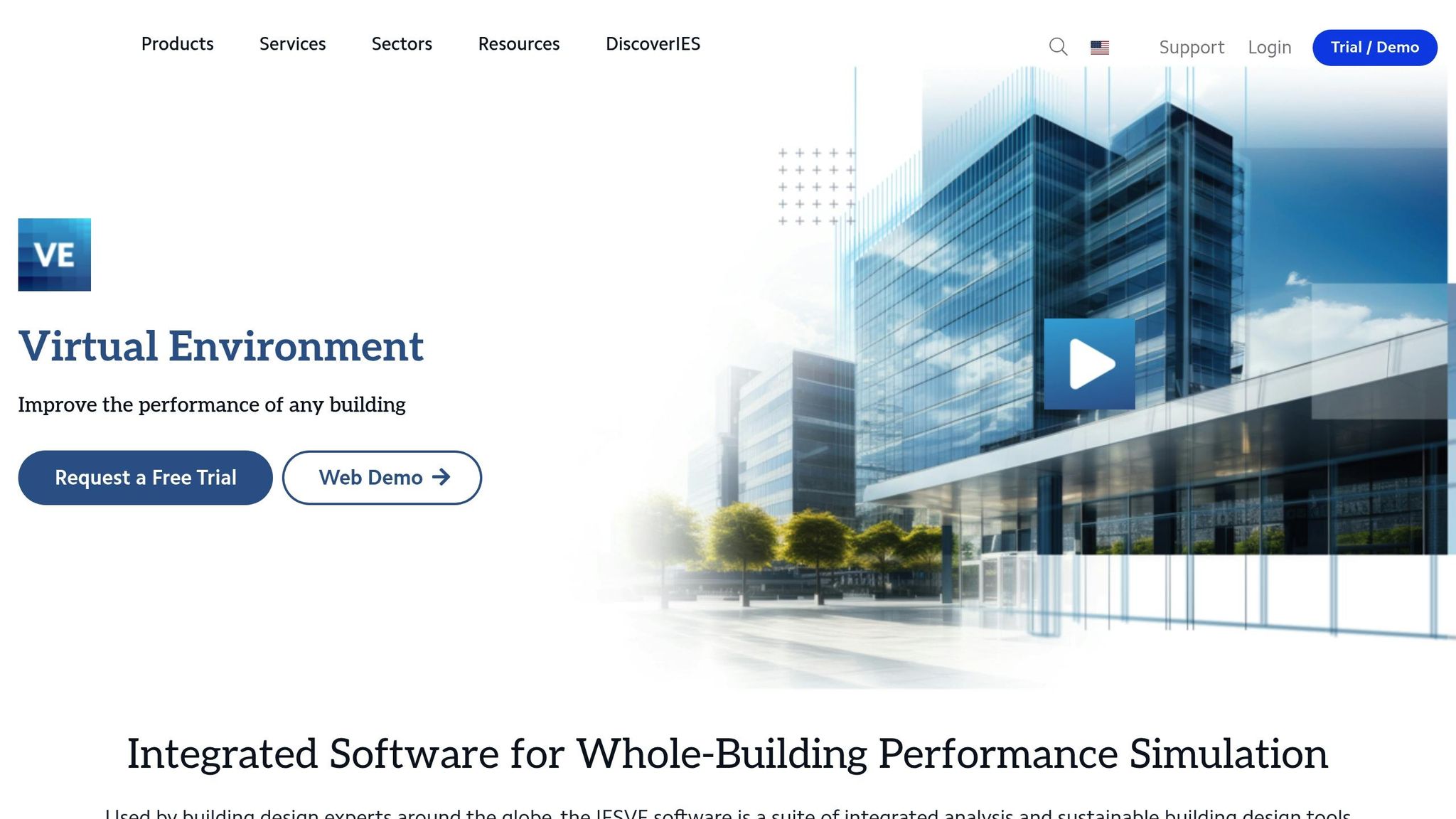
IESVE is a robust platform for building performance analysis, covering everything from initial design to operational phases. It excels in solar analysis and energy modeling, offering tools that simplify and enhance technical evaluations.
BIM Integration Capabilities
IESVE stands out for its two-way data exchange with key BIM platforms, including Revit, gbXML, IFC, and SketchUp. The IES BIM Navigator serves as a central tool for importing geometry and data, allowing users to review and select specific elements before integration. This ensures a seamless process while keeping configurations for solar analysis intact during updates.
For instance, CBG Consultants reported significant efficiency improvements after adopting the IES Revit plug-in. Ross Thompson from CBG Consultants highlighted:
"Overall the integration between Revit and IESVE made modeling run a lot quicker and smoother. It really helped us to work together better, sharing our knowledge on both platforms."
Additionally, the SketchUp plug-in streamlines model translation. A great example is the London School of Economics project, where CBG Consultants easily imported building geometry for analysis.
Solar Energy Performance Analysis Features
Leveraging its strong integration capabilities, IESVE offers advanced solar analysis tools directly connected to BIM models. It supports Solar Area Roof Access (SARA) calculations and provides automated photovoltaic array reports, making it a go-to solution for detailed solar feasibility studies.
The platform uses a single energy model throughout the building lifecycle, enabling teams to validate solar energy assumptions made during design against real-world performance once systems are operational. This approach ensures continuity and accuracy, from design optimization to operational monitoring.
For projects with complex renewable energy needs, IESVE excels by modeling solar energy alongside other building systems, offering a complete view of energy performance. HLM Architects used IESVE within an integrated BIM process to achieve a 35% reduction in carbon emissions under Part L 2013 standards.
U.S. Compliance and Localization
IESVE meets the requirements of major U.S. energy codes and standards, including Title 24 (California), IECC, ASHRAE 90.1, and the Florida Building Code. It also holds California Energy Commission (CEC) approval as solar-ready software, ensuring compliance with California’s strict renewable energy standards. This regulatory backing strengthens its ability to track energy performance across a building’s lifecycle.
In 2020, TLC Engineering Solutions used IESVE to conduct detailed energy modeling for Boca Raton Regional Hospital, ensuring compliance with the 2020 Florida Building Energy Code. The platform also includes weather files and location settings tailored to various U.S. climate zones, ensuring accurate solar performance calculations based on local conditions.
Strengths and Limitations
One of IESVE’s greatest strengths is its ability to support the entire building lifecycle, from design to operation. Its single-model approach ensures consistent solar performance tracking and optimization over time.
The software also shines in interoperability, working seamlessly with multiple BIM platforms. Jean Carriere from Trailloop emphasized this benefit:
"The ability to interoperate seamlessly between both Revit and the IESVE allows you to leverage the best of both applications in a shared BIM environment."
Its strong focus on regulatory compliance is another key advantage, particularly for U.S. projects that must meet diverse energy codes and standards. For instance, AECOM used IESVE to achieve LEED Energy Modeling for the Golden One Center, the first indoor sports venue to earn LEED Platinum certification.
4. PVsyst
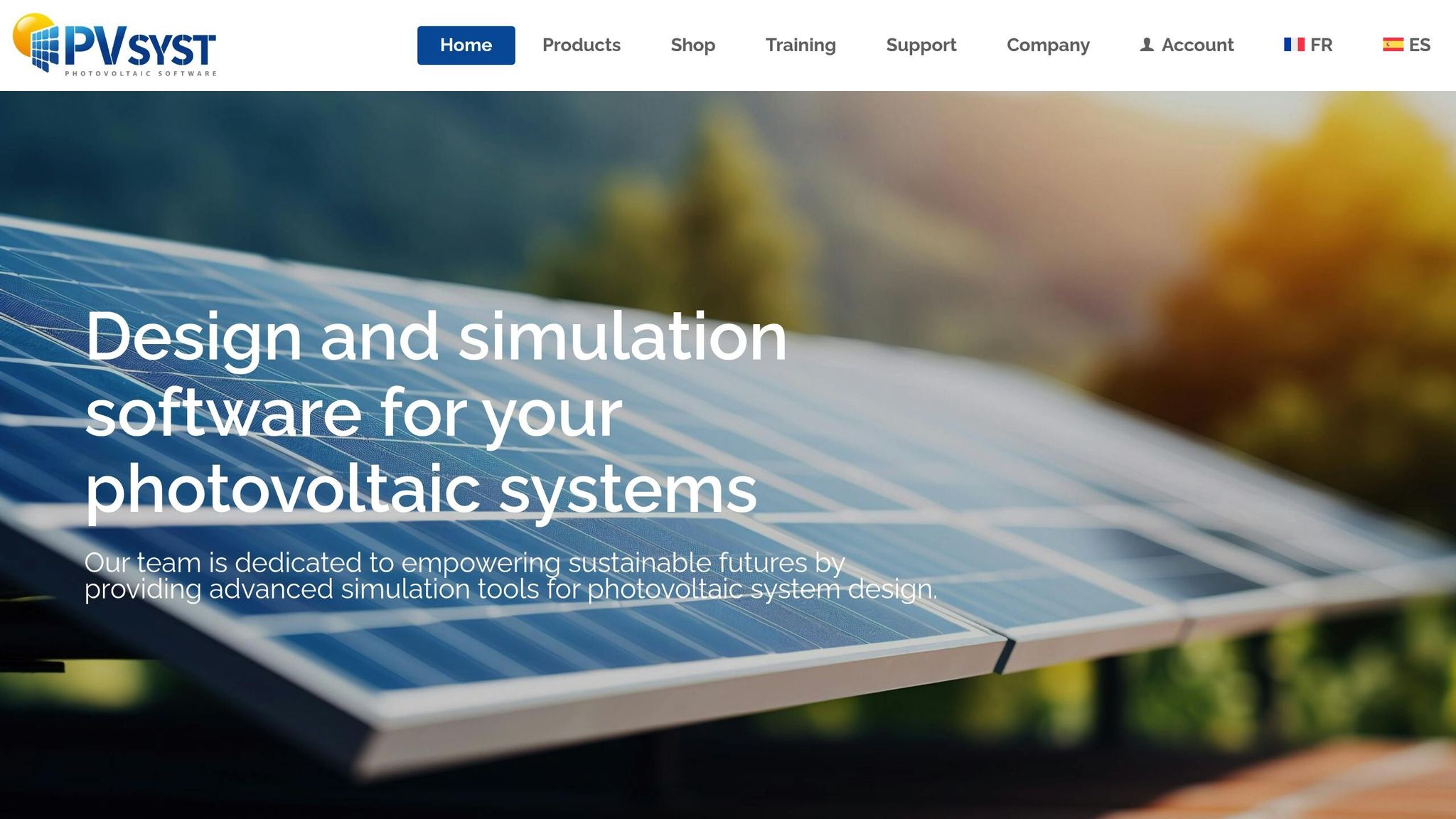
After exploring BIM-based tools, let’s dive into PVsyst – a specialized software designed specifically for precise solar energy simulations. PVsyst focuses on analyzing and sizing photovoltaic (PV) systems, offering a level of detail that complements BIM workflows. While it’s not a BIM tool itself, it provides critical insights into solar performance that enhance overall project planning.
BIM Integration Capabilities
PVsyst functions as a standalone solar simulation tool, but it can complement BIM workflows by allowing manual transfer of building models for detailed solar performance analysis. This approach helps close the gap between CAD-based BIM environments and PV-specific simulations, improving accuracy in evaluating Building Integrated Photovoltaics (BIPV) performance.
The software supports a wide range of project types, such as grid-connected, stand-alone, pumping, and DC-grid PV systems. These project types are often first modeled in BIM tools, making PVsyst a natural companion for detailed solar energy analysis.
Solar Energy Performance Analysis Features
PVsyst enables users to input detailed specifications of their solar systems, including PV modules, inverters, and site-specific data. The software simulates system performance under various conditions, such as:
- Different panel orientations
- Site-specific locations
- Climate variations
- Electrical load and consumption patterns
Users can predict energy production and consumption on hourly, daily, or monthly scales. The software also factors in critical variables like solar irradiance, temperature, and shading, ensuring accurate performance predictions.
Customization is another key strength. PVsyst allows users to model various panel technologies, simulate complex shading scenarios, and optimize designs based on energy output, costs, or CO₂ emissions. It supports four main project design systems: Standalone, Grid-connected, Hybrid, and Solar Thermal configurations.
For lifecycle analysis, PVsyst estimates CO₂ emissions, material needs, maintenance expenses, and end-of-life considerations. This lifecycle tracking adds depth to solar energy projects, complementing BIM’s broader focus on building performance.
U.S. Compliance and Localization
PVsyst is well-equipped for U.S. solar projects, offering extensive weather data and a robust PV component database tailored to the U.S. market. It integrates weather data from sources such as ASHRAE IWEC2, NREL’s National Solar Radiation Database (NSRD), SolarAnywhere, Solargis, Solcast, and Vaisala. Additionally, users can customize site management and reports with U.S.-specific date formats.
Strengths and Limitations
PVsyst is renowned for its precision and versatility in PV system simulation. With advanced algorithms and detailed databases, it delivers accurate performance models that account for real-world conditions. Its ability to simulate complex scenarios and optimize designs makes it an indispensable tool for solar energy professionals.
However, the software does have its drawbacks. The lack of direct BIM integration means users must manually transfer data between PVsyst and BIM platforms. This manual process can lead to inefficiencies, as teams must maintain separate models and update solar performance data independently when building designs evolve. While PVsyst excels in detailed analysis, its reliance on manual workflows sets it apart from more integrated BIM tools covered earlier.
5. Sefaira
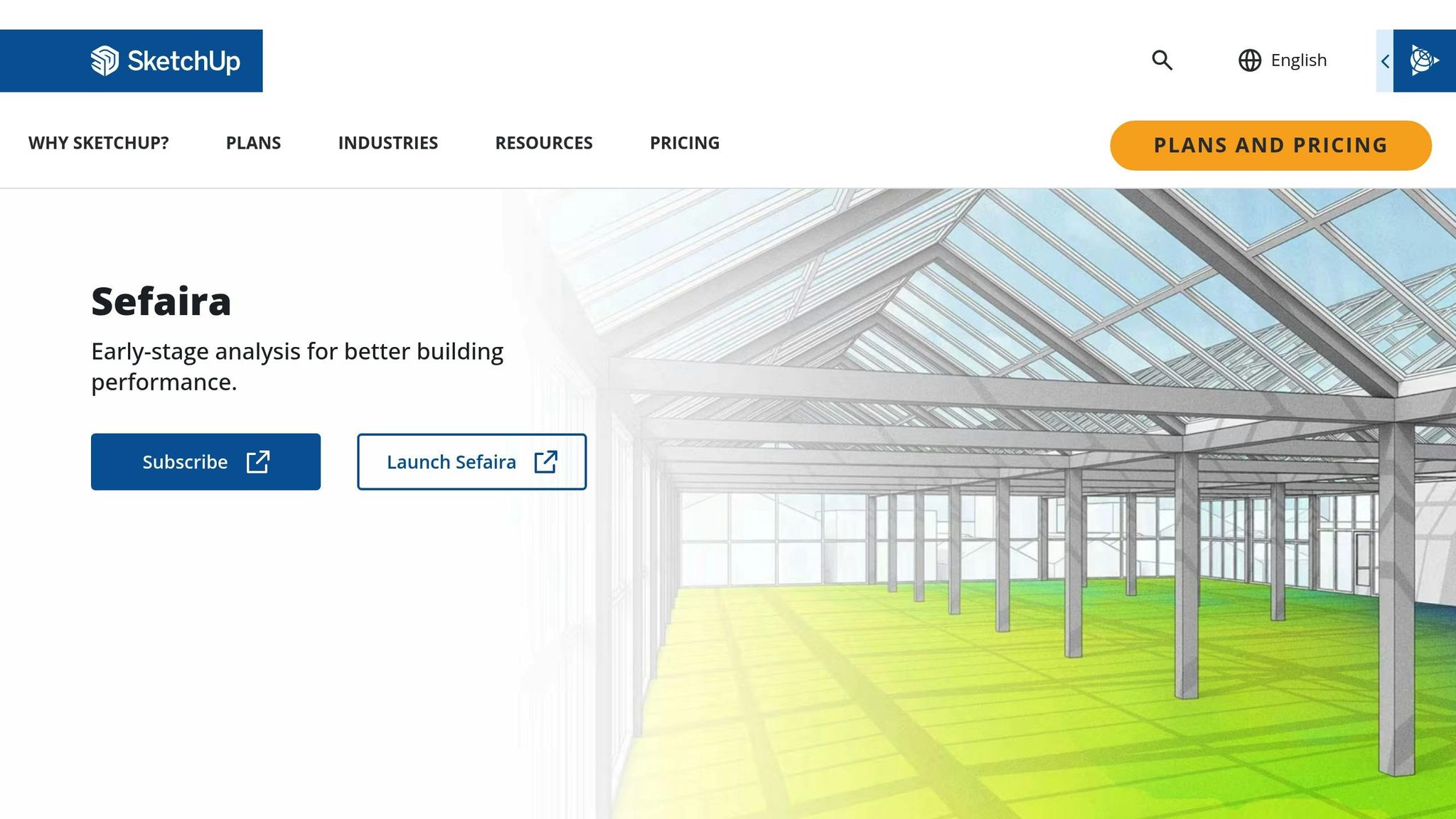
Sefaira stands out as a tool designed to optimize energy performance during the early stages of building design. This cloud-based software integrates directly with BIM tools, focusing on the critical design phase where decisions about form, mass, and envelope have the most impact on energy efficiency. Over 200 architecture firms worldwide rely on Sefaira to refine their designs from the ground up.
BIM Integration Capabilities
Sefaira works seamlessly with Autodesk Revit and SketchUp, allowing energy analysis to begin as soon as the first design concepts take shape. The Sefaira for Revit plugin supports parametric analysis, helping designers fine-tune elements like shading, glazing, and building orientation within their familiar workflows.
Paul de Ruiter from Architectenbureau Paul de Ruiter highlights the benefits:
"As an active BIM user, the integration with Revit was one of the key reasons we chose Sefaira. Sefaira makes the BIM process even more efficient whilst making better performing buildings."
For broader energy analysis, Sefaira’s web app enables whole-building assessments and renewable energy studies. Teams can compare design scenarios and conduct parametric studies with a cloud-based engine that delivers results in seconds, requiring minimal input to kickstart the process.
Solar Energy Performance Analysis Features
Using EnergyPlus as its calculation engine, Sefaira provides detailed insights into energy use, water consumption, carbon emissions, and thermal comfort. These metrics help architects evaluate energy costs and renewable energy potential.
The platform allows users to test various design parameters, such as shading and orientation, to enhance overall building performance. Full annual simulations powered by industry-accredited tools let architects compare massing, layout, and envelope designs to identify the most efficient options for incorporating solar energy.
Daylight analysis, a key factor in solar energy planning, is another area where Sefaira excels. The software offers outputs like Daylight Factor, Direct Sun Exposure, and Annual Daylight metrics (including Spatial Daylight Autonomy sDA). For further analysis, users can export Radiance and Daysim input files from completed daylight simulations.
U.S. Compliance and Localization
Sefaira adheres to ASHRAE 290 and LEED v4 Early Stage Energy Analysis standards, making it a strong choice for U.S.-based projects requiring these certifications. Its calculations align with energy codes using dynamic annual simulations, offering reliable estimates of energy performance during the Schematic Design phase.
The platform provides early-stage performance feedback, helping users determine whether their designs are aligned with energy code requirements. It also supports reporting to the AIA DDx (direct data exchange), allowing teams to track progress against energy, daylight, and comfort goals within established industry standards.
Strengths and Limitations
Sefaira’s primary strength lies in its ability to simplify early-stage energy analysis. Its user-friendly interface, integration with popular design tools, and cloud-based functionality make energy modeling more accessible for architects and engineers. Heather Gayle Holdridge from Lake Flato Architects underscores its value:
"It is important to have building performance simulation integrated into this process as well. Decisions related to energy and daylighting are critical and this kind of information will be more accessible if they are integrated into the tools we already effectively utilize."
That said, Sefaira does have limitations. Its interface lacks the depth and control of full EnergyPlus capabilities, making it less suitable for detailed energy code submissions. While it provides excellent guidance in the early stages, teams often need to transition to more advanced tools or native EnergyPlus for final compliance documentation as projects progress.
sbb-itb-51876bd
Feature Comparison Table
Here’s a quick breakdown of key features and compliance standards across leading BIM tools for solar performance analysis. Use this table to match your project needs with the strengths of each tool.
| Feature | EasySolar | Autodesk Insight | IESVE | PVsyst | Sefaira |
|---|---|---|---|---|---|
| Primary Focus | AI-driven solar design & sales | Building energy optimization | Comprehensive building performance | PV system simulation | Early-stage energy modeling |
| BIM Integration | Direct workflow integration | Native Revit compatibility | Plugins for Revit, ArchiCAD, SketchUp | IFC import/export, CAD support | Revit & SketchUp plugins |
| Solar Analysis Capabilities | Automated panel design, shading, financial modeling | Solar irradiance, renewable potential | PV performance, shading, solar thermal | PV yield simulation, loss analysis | Solar potential assessment, design comparisons |
| Visualization Features | Drone photo overlays, 3D renderings | Interactive 3D energy models | Real-time performance dashboards | 3D shading visuals, loss diagrams | Cloud-based scenario analysis |
| U.S. Compliance | Custom U.S. financial analysis | ASHRAE 90.1, LEED standards | ASHRAE, Title 24, IECC | IEEE standards, NEC guidelines | LEED v4, ASHRAE 290, AIA DDx reporting |
| Lifecycle Tracking | Sales tracking, project management | Energy performance monitoring | Full lifecycle analysis | 20+ years of PV system performance | Early-stage performance predictions |
| Collaboration Tools | CRM, team management, custom proposals | Cloud sharing, multi-user access | Team collaboration, reporting tools | Project documentation, data export | Web-based team collaboration |
| Pricing Model | $25–35/user/month | Subscription-based | Enterprise licensing | One-time purchase + maintenance | Subscription-based |
| Best For | Solar sales teams, installers | Architects, energy consultants | Large-scale projects | PV system designers, engineers | Early-stage design teams |
Key Performance Differentiators
Each tool stands out in its own way. EasySolar simplifies solar design with AI automation, while PVsyst excels in delivering precise long-term performance simulations. IESVE offers a full lifecycle approach to building performance, and Sefaira is tailored for early-stage design optimization.
Integration and Workflow Considerations
Seamless integration is a priority for these tools. Most support IFC data sharing, ensuring compatibility across BIM platforms. Autodesk Insight offers native integration with Revit, while EasySolar provides cloud-based access and drone photo integration, making it particularly useful for on-site management and streamlining workflows from sales to installation.
Compliance and Certification Support
All tools align with key U.S. energy standards such as LEED, ASHRAE, and Title 24. Sefaira, for instance, supports AIA DDx reporting, helping teams measure progress against energy and daylight goals – an increasingly important feature for architectural firms focusing on sustainable design certifications.
This comparison highlights how these BIM tools contribute to optimizing solar energy performance across a system’s lifecycle, making them indispensable for projects aiming to combine efficiency with compliance.
Conclusion
Choosing the right BIM tool can make a significant difference in the success of solar energy projects, especially as sustainable building practices gain momentum. Each tool we’ve discussed brings its own strengths to the table, so it’s important to align your choice with your project’s specific needs.
For example, EasySolar simplifies sales processes, while PVsyst excels at precise simulations. If your focus is on full lifecycle modeling, IESVE is a strong option, and Sefaira provides valuable insights during the early design stages. Beyond functionality, regulatory compliance is critical. These tools are designed to work with major U.S. standards like LEED, ASHRAE, and Title 24, ensuring your project meets energy codes and achieves success.
Collaboration and workflow integration also play a pivotal role. Cloud-based platforms make it easier for architects, engineers, and contractors to work together, while robust BIM integration ensures smooth data sharing across every project phase. BIM tools also provide the ability to assess the entire lifecycle of a solar installation, optimizing panel placement and system design to capture maximum energy while keeping embodied carbon in check.
FAQs
How does EasySolar’s AI-powered automation improve solar energy performance analysis?
How EasySolar Simplifies Solar Energy Analysis
EasySolar leverages AI-powered automation to tackle the complexities of solar energy performance analysis. It takes care of time-consuming tasks like site assessments, shading evaluations, and energy output predictions. The result? Faster, more precise system designs with minimal room for human error.
In addition, EasySolar automates performance reporting and project management. This not only helps maximize energy output but also shortens project timelines and enhances decision-making. These streamlined processes make it simpler to deliver dependable, cost-efficient solar solutions tailored to fit your specific requirements.
What U.S. compliance standards does EasySolar support, and how does it ensure regulatory adherence?
EasySolar simplifies regulatory compliance in the U.S. by automating checks for local permitting requirements. This includes verifying zoning laws, environmental guidelines, and other jurisdiction-specific rules. By handling these tasks, the platform speeds up the approval process for solar energy projects while ensuring adherence to both national and local standards.
Beyond U.S. regulations, EasySolar also meets international safety and electromagnetic compatibility standards. This ensures the tools deliver reliable quality and performance. With its attention to both local and global compliance, EasySolar empowers users to design, manage, and implement solar energy systems with confidence across the country.
How does EasySolar’s integration with BIM tools enhance collaboration between architects, engineers, and solar installers?
EasySolar’s Integration with BIM Tools
EasySolar’s integration with Building Information Modeling (BIM) tools brings teams together by providing a shared platform where architects, engineers, and solar installers can collaborate seamlessly. Through detailed 3D models and real-time project data, everyone stays on the same page, working with the most current information. This setup also helps identify potential issues early through clash detection, reducing costly errors.
By simplifying workflows and boosting communication, this integration empowers teams to make smarter decisions and deliver solar energy projects that are both efficient and environmentally friendly. The result? A streamlined process from design to execution that saves time, cuts costs, and ensures top-notch results.

